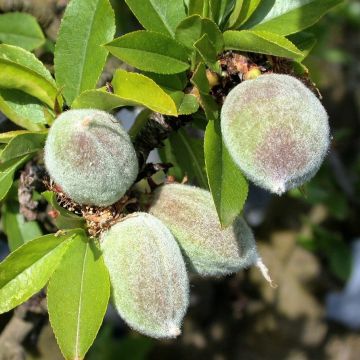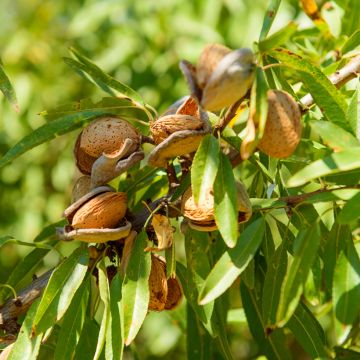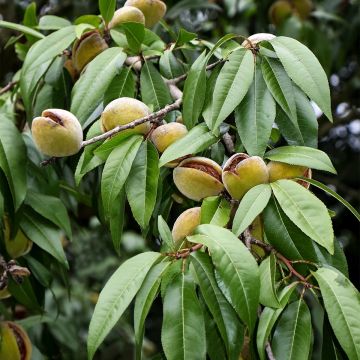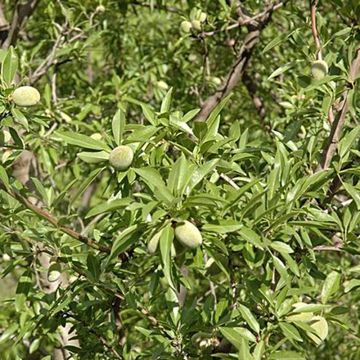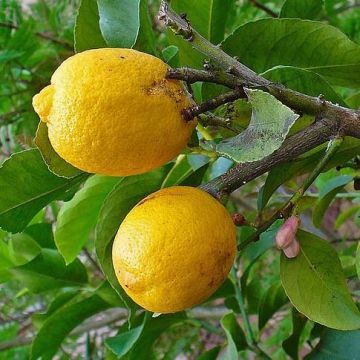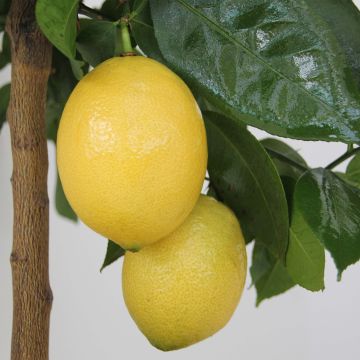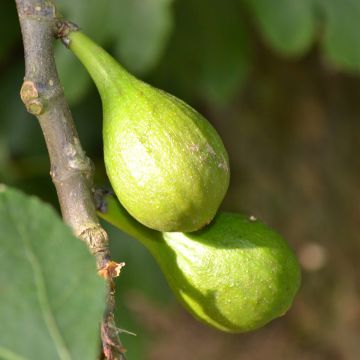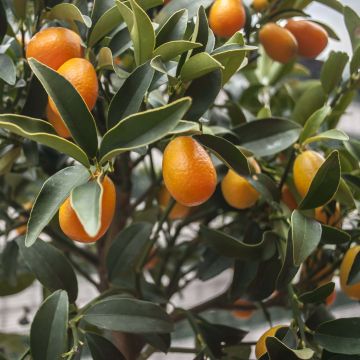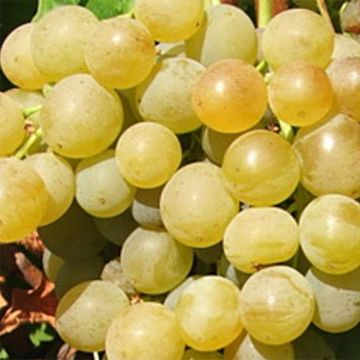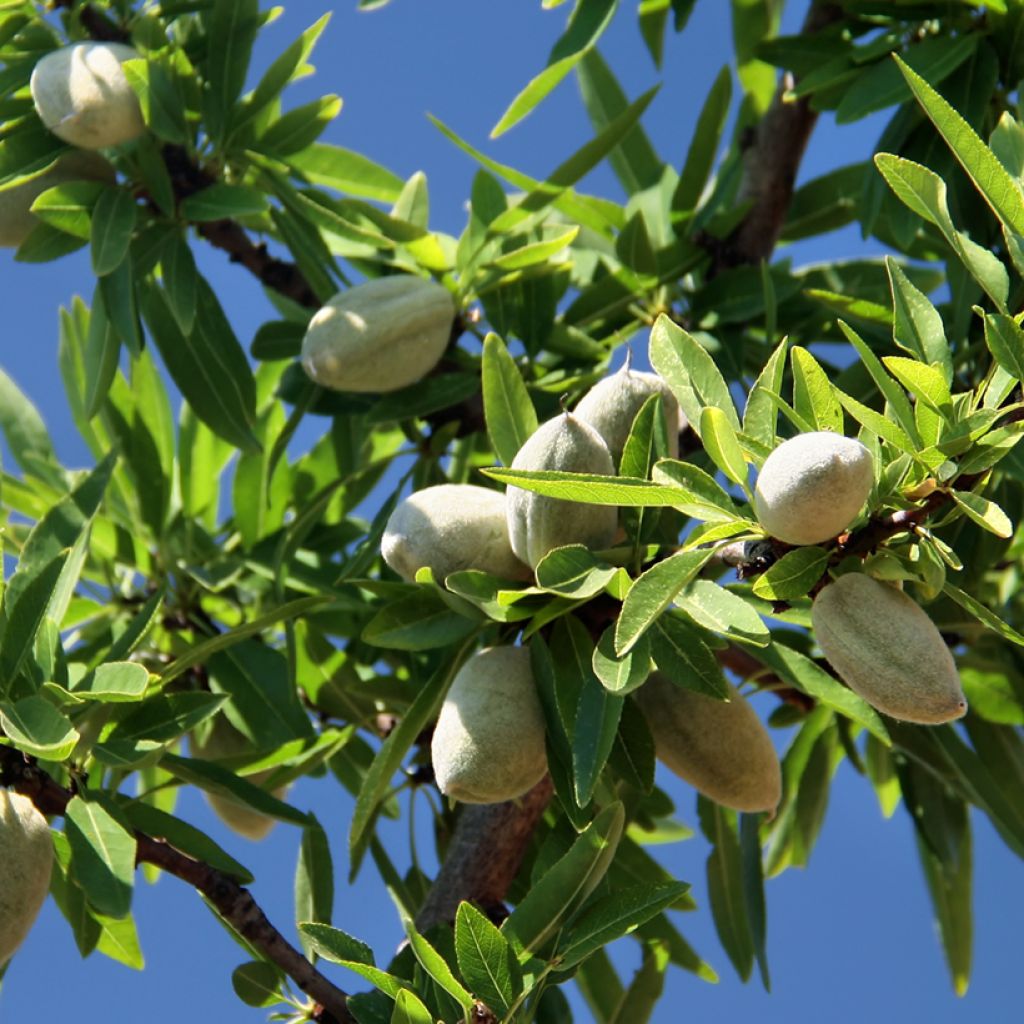

Amandier Aï Bio - Prunus dulcis


Amandier Aï Bio - Prunus dulcis
Prunus dulcis Aï - Almond Tree
Prunus dulcis Aï
Almond
Special offer!
Receive a €20 voucher for any order over €90 (excluding delivery costs, credit notes, and plastic-free options)!
1- Add your favorite plants to your cart.
2- Once you have reached €90, confirm your order (you can even choose the delivery date!).
3- As soon as your order is shipped, you will receive an email containing your voucher code, valid for 3 months (90 days).
Your voucher is unique and can only be used once, for any order with a minimum value of €20, excluding delivery costs.
Can be combined with other current offers, non-divisible and non-refundable.
Home or relay delivery (depending on size and destination)
Schedule delivery date,
and select date in basket
This plant carries a 6 months recovery warranty
More information
We guarantee the quality of our plants for a full growing cycle, and will replace at our expense any plant that fails to recover under normal climatic and planting conditions.
Description
Prunus dulcis Ai, from Organic Agriculture, is a fruit-bearing and ornamental tree, highly valued for its fruit and its exceptional blossom in late winter. It produces elongated, flattened, fuzzy, green fruits which turn beige when ripe and are approximately 5 cm (2in) long. Under the flesh is a woody stone with a soft shell that contains the almond. The 'Ai' variety produces a wide and flat almond (kernel), of excellent sweet flavour, which can be consumed fresh in July. It is more commonly consumed dried, after harvesting, from mid-September, when the green and fuzzy fleshy envelope, called the hull, opens. The almond has a very long shelf life when dried. It has a multitude of culinary uses. Its nutritional qualities are remarkable. The tree is hardy but its early flowering, from late February to mid-March, does not tolerate frost. To obtain a good fruit set, it will need to be given a prime location. In addition to its splendid flowering, the flowers produce a high-quality nectar, sought after by bees. This vigorous variety of almond tree with fairly rapid fruiting and slow growth, has a lifespan of between 50 and 80 years. It is sensitive to frost and prefers a warm, sunny, and sheltered location. It is resistant to fungal diseases, particularly brown rot, but susceptible to scab.
Prunus dulcis or amygdalus (Common Almond) is a fruit tree belonging to the Rosaceae family that originated in Central or Western Asia. The almond tree was cultivated early on in the Greek islands and then throughout southern Europe and North Africa. It was introduced to the Midi region in the 5th century BC, but its development only took off in the Middle Ages. The almond tree was introduced to the United States in the 19th century, and California has become the world's leading producer. In the Prunus genus, it is closely related to cherry, apricot, and peach trees. The fruit is commonly called an "almond" just like the edible seed contained within the shell, which is also called a kernel.
The Ai variety has been cultivated since the 19th century in the Aix-en-Provence region and in Vaucluse. It forms a tree with an upright frame and spreading branches, reaching 5 to 7 metres (16 to 23 feet) high with a diameter of about 4 to 6 metres (13 to 20 feet). Its habit is suited to free forms on half-standards or low goblet forms. Its deciduous foliage is composed of lanceolate, finely toothed, 8 to 12 cm (3 to 5in) long and 3 to 4 cm (1 to 2in) wide, often pendulous, dark green leaves which take on autumnal yellow-brown hues before falling. Flowering occurs in February-March. The nectar-rich, white, 3 to 4 cm (1 to 2in) diameter flowers, appear singly or in pairs before the leaves, on the previous year's branches. They can be destroyed by frost at temperatures of -2 to -3°C. This early flowering makes it less viable further north. The flowers cover the entire tree and give the almond tree a remarkable elegance in late winter. It is hardy down to -20°C. This variety is self-sterile or self-incompatible, the flowers cannot self-pollinate. This is why the presence of other almond varieties flowering at the same time nearby is necessary. For example, the Texas, Ferragnes, and Ferraduel varieties are suitable for cross-pollination, thus increasing the number of fruits.
Only the almond (kernel) contained in the shell is edible. The fruits of Prunus dulcis Ai are harvested either milky, from July for consumption as fresh almonds, or from mid-September when the case cracks and begins to open, for use as dried almonds. Fresh almonds are hand-picked. They will only keep for a few days. In the mouth, they are juicy, astringent, and slightly milky. Eaten plain, they have a delicate and distinct taste. They can be used to make plant-based milk. In cooking, they pair very well with savoury dishes such as tagines, salads, or pastries. To harvest dried almonds, simply collect the shells from the ground, if necessary shake the tree branches to help the operation, then dry them in the sun for several days. Once removed from its case, the woody shell, which contains the almond, can be stored for up to a year in a well-ventilated, cool place. In cooking, almonds can be used in various forms: whole, roasted, sliced, crushed, as a paste, in milk or cream, for many culinary uses. They are an oily nut, which can sometimes cause allergic reactions. Almonds are used in cosmetics, particularly for their soothing and moisturising oil.
Almons are rich in fatty acids, vegetable proteins and fibre and offer a complete nutritional profile with the presence of vitamins (B and E) and minerals (calcium, magnesium, manganese, copper, phosphorus, iron, and potassium). They are a healthy choice to include in a varied and balanced diet.
Like many fruit trees, almond trees prefer light, deep, and well-drained soils, even limestone. They do not tolerate excess water or heavy, compact soils. They prefer full sun and shelter from drafts and cold winds. A south or southwest exposure is ideal. To obtain fruits, it is imperative that the blossom does not freeze, which limits almond cultivation to climatic zones governed by a Mediterranean climate with short winters like southern China, southwestern North America (California), South America (central Chile), South Africa, and Australia. With a wide range of almond varieties, it is easy to find one that suits.
Report an error about the product description
Prunus dulcis Aï - Almond Tree in pictures


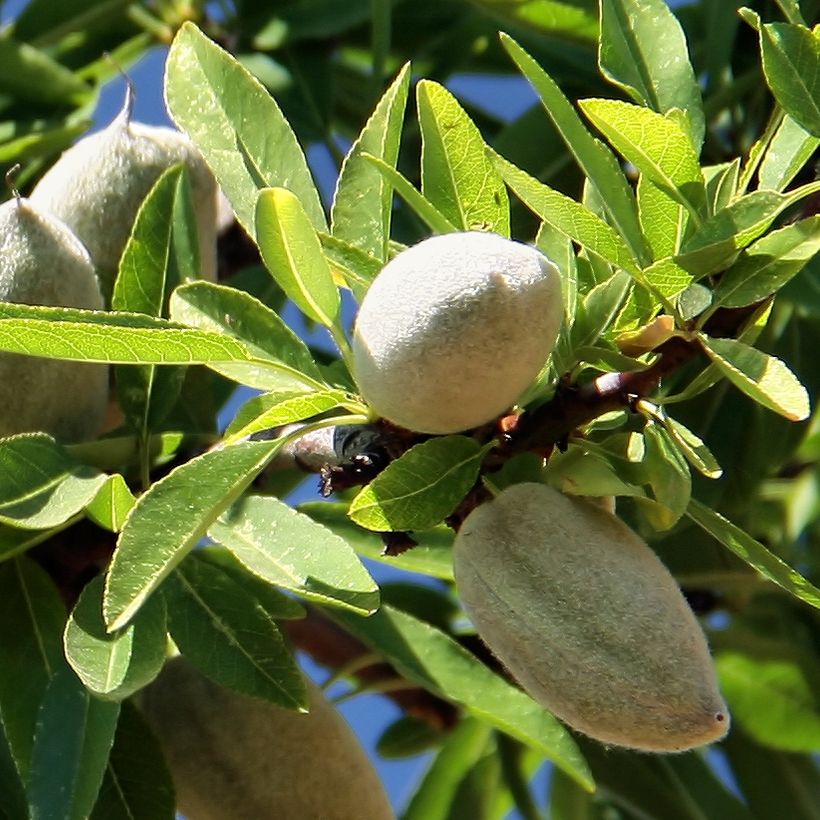

Plant habit
Fruit
Flowering
Foliage
Botanical data
Prunus
dulcis
Aï
Rosaceae
Almond
Central Asia
Other Almond trees
View all →Planting and care
The trees are best planted in autumn to allow your Ai almond to establish itself before spring since it is very early flowering and starts growing very early. Choose a sunny and sheltered location. It likes all types of soils, including rocky and slightly chalky soils, preferring well-drained and light soils. If you plant multiple plants, space them 8 to 12 m (26 to 39ft) apart.
Almond trees are sold bare-rooted or in containers. Weed carefully and remove stones from the designated location. Loosen the soil deeply with a fork. Add some sand if you find the soil too heavy. Dig a hole 50 to 60 cm (20 to 24in) deep and 80 cm (32in) wide. Throw a handful of bonemeal at the bottom of the hole and mix it with the soil. Add some extracted soil mixed with well-decomposed manure. Place a stake to keep the tree straight. Plant the almond tree so that the collar is at ground level. Fill in the planting hole and firm down. Water abundantly.
If your almond tree is bare-rooted, remember to prune and praline the roots before planting. Pruning involves cutting the ends of the roots, and pralining means soaking them in a mixture consisting of one-third garden soil, one-third compost, and one-third rainwater. Pralining helps eliminate air pockets between the roots and the soil.
Almond trees are susceptible to many fungal or bacterial diseases and a number of pests can attack them. Among the diseases, the most common are moniliosis, which causes the flowers to wither and cankers to appear on the branches, and peach leaf curl, characterised by leaf deformation and discolouration. Another fungal disease that affects almond trees is Coryneum blight or shot hole disease. This fungus attacks the leaves, branches, and fruits at the same time, causing the almond tree to wither. Verticillium wilt can also affect almond trees, as well as other fruit trees. It manifests as browning and curling of the leaves. You may also encounter fruit tree rust, scab, anthracnose, and red spot disease.
The pests mainly include red spider mites and almond rust mites, peach leaf miners, and green aphids.
Planting period
Intended location
Care
This item has not been reviewed yet - be the first to leave a review about it.
Similar products
Haven't found what you were looking for?
Hardiness is the lowest winter temperature a plant can endure without suffering serious damage or even dying. However, hardiness is affected by location (a sheltered area, such as a patio), protection (winter cover) and soil type (hardiness is improved by well-drained soil).

Photo Sharing Terms & Conditions
In order to encourage gardeners to interact and share their experiences, Promesse de fleurs offers various media enabling content to be uploaded onto its Site - in particular via the ‘Photo sharing’ module.
The User agrees to refrain from:
- Posting any content that is illegal, prejudicial, insulting, racist, inciteful to hatred, revisionist, contrary to public decency, that infringes on privacy or on the privacy rights of third parties, in particular the publicity rights of persons and goods, intellectual property rights, or the right to privacy.
- Submitting content on behalf of a third party;
- Impersonate the identity of a third party and/or publish any personal information about a third party;
In general, the User undertakes to refrain from any unethical behaviour.
All Content (in particular text, comments, files, images, photos, videos, creative works, etc.), which may be subject to property or intellectual property rights, image or other private rights, shall remain the property of the User, subject to the limited rights granted by the terms of the licence granted by Promesse de fleurs as stated below. Users are at liberty to publish or not to publish such Content on the Site, notably via the ‘Photo Sharing’ facility, and accept that this Content shall be made public and freely accessible, notably on the Internet.
Users further acknowledge, undertake to have ,and guarantee that they hold all necessary rights and permissions to publish such material on the Site, in particular with regard to the legislation in force pertaining to any privacy, property, intellectual property, image, or contractual rights, or rights of any other nature. By publishing such Content on the Site, Users acknowledge accepting full liability as publishers of the Content within the meaning of the law, and grant Promesse de fleurs, free of charge, an inclusive, worldwide licence for the said Content for the entire duration of its publication, including all reproduction, representation, up/downloading, displaying, performing, transmission, and storage rights.
Users also grant permission for their name to be linked to the Content and accept that this link may not always be made available.
By engaging in posting material, Users consent to their Content becoming automatically accessible on the Internet, in particular on other sites and/or blogs and/or web pages of the Promesse de fleurs site, including in particular social pages and the Promesse de fleurs catalogue.
Users may secure the removal of entrusted content free of charge by issuing a simple request via our contact form.
The flowering period indicated on our website applies to countries and regions located in USDA zone 8 (France, the United Kingdom, Ireland, the Netherlands, etc.)
It will vary according to where you live:
- In zones 9 to 10 (Italy, Spain, Greece, etc.), flowering will occur about 2 to 4 weeks earlier.
- In zones 6 to 7 (Germany, Poland, Slovenia, and lower mountainous regions), flowering will be delayed by 2 to 3 weeks.
- In zone 5 (Central Europe, Scandinavia), blooming will be delayed by 3 to 5 weeks.
In temperate climates, pruning of spring-flowering shrubs (forsythia, spireas, etc.) should be done just after flowering.
Pruning of summer-flowering shrubs (Indian Lilac, Perovskia, etc.) can be done in winter or spring.
In cold regions as well as with frost-sensitive plants, avoid pruning too early when severe frosts may still occur.
The planting period indicated on our website applies to countries and regions located in USDA zone 8 (France, United Kingdom, Ireland, Netherlands).
It will vary according to where you live:
- In Mediterranean zones (Marseille, Madrid, Milan, etc.), autumn and winter are the best planting periods.
- In continental zones (Strasbourg, Munich, Vienna, etc.), delay planting by 2 to 3 weeks in spring and bring it forward by 2 to 4 weeks in autumn.
- In mountainous regions (the Alps, Pyrenees, Carpathians, etc.), it is best to plant in late spring (May-June) or late summer (August-September).
The harvesting period indicated on our website applies to countries and regions in USDA zone 8 (France, England, Ireland, the Netherlands).
In colder areas (Scandinavia, Poland, Austria...) fruit and vegetable harvests are likely to be delayed by 3-4 weeks.
In warmer areas (Italy, Spain, Greece, etc.), harvesting will probably take place earlier, depending on weather conditions.
The sowing periods indicated on our website apply to countries and regions within USDA Zone 8 (France, UK, Ireland, Netherlands).
In colder areas (Scandinavia, Poland, Austria...), delay any outdoor sowing by 3-4 weeks, or sow under glass.
In warmer climes (Italy, Spain, Greece, etc.), bring outdoor sowing forward by a few weeks.
































